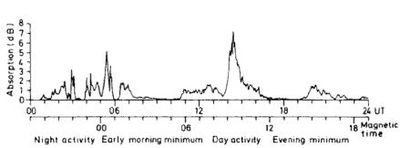
Ionospheric absorption
Encyclopedia

Absorption (electromagnetic radiation)
In physics, absorption of electromagnetic radiation is the way by which the energy of a photon is taken up by matter, typically the electrons of an atom. Thus, the electromagnetic energy is transformed to other forms of energy for example, to heat. The absorption of light during wave propagation is...
occurring as a result of the interaction between various types of electromagnetic waves
Electromagnetic radiation
Electromagnetic radiation is a form of energy that exhibits wave-like behavior as it travels through space...
and the free electrons in the ionosphere
Ionosphere
The ionosphere is a part of the upper atmosphere, comprising portions of the mesosphere, thermosphere and exosphere, distinguished because it is ionized by solar radiation. It plays an important part in atmospheric electricity and forms the inner edge of the magnetosphere...
, which can interfere with radio
Radio
Radio is the transmission of signals through free space by modulation of electromagnetic waves with frequencies below those of visible light. Electromagnetic radiation travels by means of oscillating electromagnetic fields that pass through the air and the vacuum of space...
transmissions.
Description
Ionosphere absorption is of critical importance when radio networkRadio network
There are two types of radio networks currently in use around the world: the one-to-many broadcast type commonly used for public information and mass media entertainment; and the two-way type used more commonly for public safety and public services such as police, fire, taxicabs, and delivery...
s, telecommunication systems or interlinked radio systems are being planned, particularly when trying to determine propagation
Radio propagation
Radio propagation is the behavior of radio waves when they are transmitted, or propagated from one point on the Earth to another, or into various parts of the atmosphere...
conditions.
The ionosphere can be described as an area of the atmosphere in which radio waves
Radio frequency
Radio frequency is a rate of oscillation in the range of about 3 kHz to 300 GHz, which corresponds to the frequency of radio waves, and the alternating currents which carry radio signals...
on shortwave bands
Shortwave bands
Shortwave bands are frequency allocations for use within the shortwave radio spectrum . They are the primary medium for applications such as maritime communications, international broadcasting and worldwide amateur radio activity because they take advantage of ionospheric skip propagation to send...
are refracted or reflected back to earth. As a result of this reflection, which is often key in the long-distance propagation of radio waves,some of the shortwave signal strength
Signal strength
In telecommunications, particularly in radio, signal strength refers to the magnitude of the electric field at a reference point that is a significant distance from the transmitting antenna. It may also be referred to as received signal level or field strength. Typically, it is expressed in...
is decreased. In this regard, ISAB is the primary limiting factor
Limiting factor
A limiting factor or limiting resource is a factor that controls a process, such as organism growth or species population, size, or distribution. The availability of food, predation pressure, or availability of shelter are examples of factors that could be limiting for an organism...
in radio propagation.
Attenuation mechanics

Solar wind
The solar wind is a stream of charged particles ejected from the upper atmosphere of the Sun. It mostly consists of electrons and protons with energies usually between 1.5 and 10 keV. The stream of particles varies in temperature and speed over time...
and radiation cause the ionosphere to become charged with electrons in the first place. At night, the atmosphere becomes drained of its charge, and radio signals can go much further with less loss of signal. In particular, low wavelength
Wavelength
In physics, the wavelength of a sinusoidal wave is the spatial period of the wave—the distance over which the wave's shape repeats.It is usually determined by considering the distance between consecutive corresponding points of the same phase, such as crests, troughs, or zero crossings, and is a...
signals that would be attenuated to nothing during the day will be received much further away at night.
The specific amount of attenuation can be derived as a function of the Inverse-square law
Inverse-square law
In physics, an inverse-square law is any physical law stating that a specified physical quantity or strength is inversely proportional to the square of the distance from the source of that physical quantity....
. The lower the frequency, the greater the attenuation.

